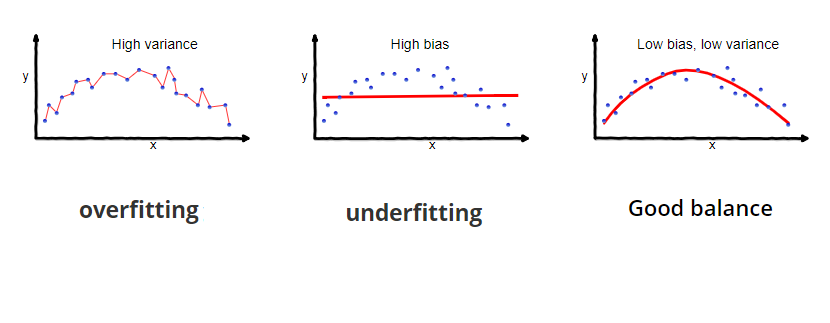Modeling and Evaluation¶
Steps in “almost every” modeling problem:
Machine Learning¶
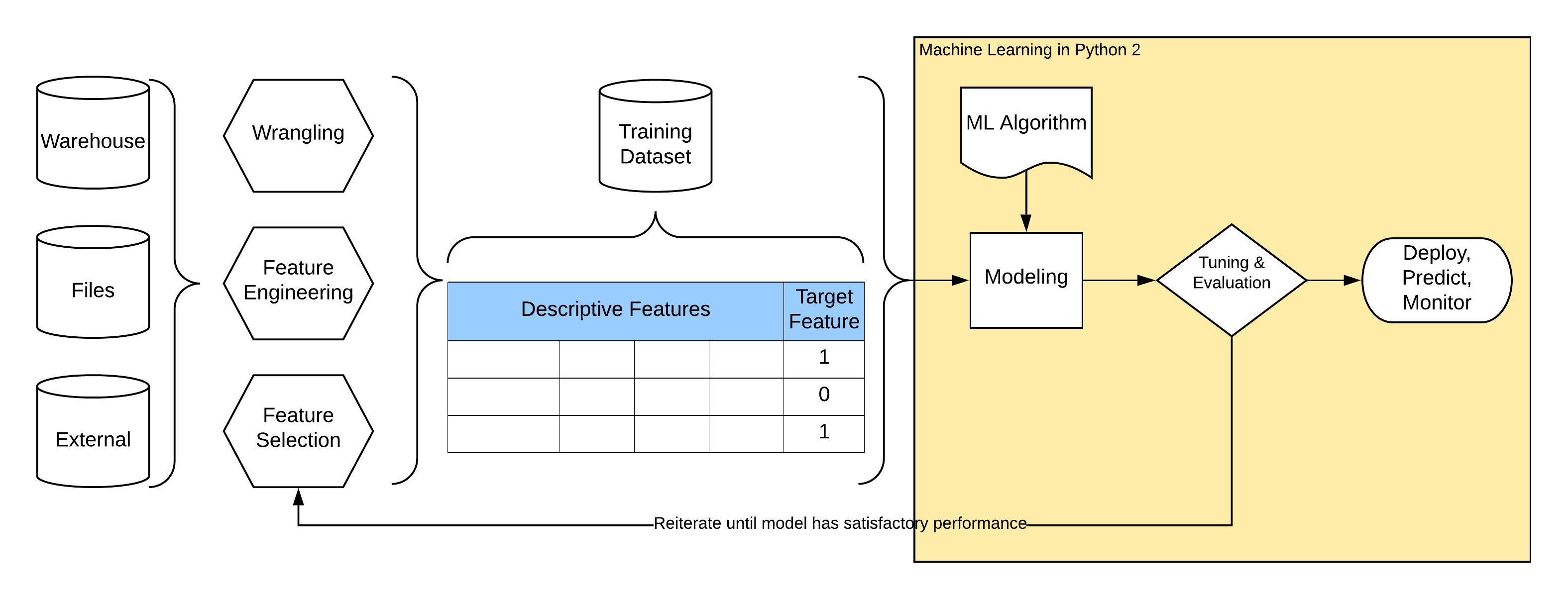
Supervised machine learning can be stated as follows. Find “the best” function \(f\) that given set of \(M\) descriptive features and \(N\) instances of data \(X_{11}, ..., X_{NM}\) returns values of target feature \(y\).
The model to find is the unknown function \(f\).
ML Pipeline¶
It is very useful to define complete machine learning pipeline in a declarative way using some higher-level stages (primitives) like transformers, estimators, and pipelines. Some advantages:
Any data transformation has to be “recorded” and replicated at all places where modeling happends (at least training and predicting).
Stages could be tested in isolation and reused among multiple ml pipelines.
Transformations applied are easy to read when described declaratively than programatically eg. using pandas df opps.

We split our dataset into train and test (holdout) datasets, we train on training data and evaluate model perfomance on unseen test dataset to simulate reality and to prevent overfitting of the model.
We replicate most of data transformations described in previous lecture using sklearn transformers.
# import some basic libraries to do analysis and ML
import pandas as pd
import numpy as np
import sklearn as sk
import matplotlib as mpl
import matplotlib.pyplot as plt
import matplotlib.pylab as pylab
import seaborn as sns
%matplotlib inline
import warnings
warnings.filterwarnings('ignore')
# Visualization details
mpl.style.use('ggplot')
sns.set_style('white')
pylab.rcParams['figure.figsize'] = 6,6
Do basic preprocessing of available data. It makes sense to apply these transformations everywhere where we plan to use the model. ‘No’s and ‘Yes’s are better understood as zeros and ones.
# Read data from local .csv file and do basic preprocessing that makes sense to do everywhere
df = pd.read_csv('weatherAUS.csv')
df['RainToday'] = df['RainToday'].replace({'Yes': 1, 'No': 0})
df['RainTomorrow'] = df['RainTomorrow'].replace({'Yes': 1, 'No': 0})
df['DateD'] = pd.to_datetime(df.Date, format='%Y-%m-%d')
df['RainTodayD'] = df['RainToday'].map(lambda l: 1 if l == 'Yes' else 0)
df['Year'] = df['DateD'].dt.year
df['Month'] = df['DateD'].dt.month
df['YearMonth'] = df[['Year', 'Month']].apply(lambda r: f'{r[0]}-{r[1]:02d}', axis=1)
# Calculate rolling features that are hard to do in production but we check their importance here
def agg_days_since_rain(x):
x = x[:-1]
r = np.argmax(np.flip(x)) + 1 if x.any() else 20
return r
def agg_rain_days(x):
return np.sum(x[:-1])
def rolling_feature(d, by, on, val, window, name, agg_fce):
cs = [by, on]
r = d.sort_values(cs).groupby(by).rolling(window, on=on, min_periods=1)
agg = r.apply(agg_fce, raw=True)
agg[name] = agg[val] # agg has aggregated values in column val
agg.drop([val, on], axis=1, inplace=True)
agg.rename_axis(index=(by, 'Id'), inplace=True)
agg.reset_index(inplace=True)
return agg
# rolling_feature is custom rolling window function that takes different aggregation functions
dsrw = rolling_feature(df[['DateD', 'Location', 'RainToday']], 'Location', 'DateD', 'RainToday', 8, 'DaysSinceRainWeek', agg_days_since_rain)
rdw = rolling_feature(df[['DateD', 'Location', 'RainToday']], 'Location', 'DateD', 'RainToday', 8, 'RainDaysWeek', agg_rain_days)
# prepare original dataset to have the same index as rv
d = df.copy()
d.set_index(['Location'], append=True, inplace=True)
d.rename_axis(('Id', 'Location'), inplace=True)
d.reset_index(inplace=True)
# merge new features and drop technical columns
d = d.merge(dsrw, on=['Id', 'Location'])
d = d.merge(rdw, on=['Id', 'Location'])
d['NoRainWeek'] = d['DaysSinceRainWeek'].map(lambda l: 1 if l == 20 else 0)
d['DaysSinceRainWeek'] = d['DaysSinceRainWeek'].replace({20: 0})
df = d
We map input columns (features) from data frame to the input of model. All sklearn models require only numerical data as input, we impute missing values and add few basic transformations to test.
Imputing without any further transformations:
from sklearn.preprocessing import PowerTransformer, StandardScaler, OneHotEncoder, FunctionTransformer
from sklearn.experimental import enable_iterative_imputer
from sklearn.impute import IterativeImputer, SimpleImputer
from sklearn.pipeline import make_pipeline as mp
Build ML Pipeline¶
First, we have to impute using different strategies based on our EDA.
print('We keep indicator for features with a lot of missing values.')
df.isnull().sum().sort_values(ascending=False).head(4)
We keep indicator for features with a lot of missing values.
Sunshine 67816
Evaporation 60843
Cloud3pm 57094
Cloud9am 53657
dtype: int64
features = []
ff = ['Cloud9am', 'Cloud3pm']
features += [('~indicator1', SimpleImputer(strategy='mean', add_indicator=True), ff)]
Mean or median by number of outliers in features.
# boxplots
cols = ['Temp3pm', 'Evaporation', 'Humidity9am']
m = pd.melt(df[cols + ['Date', 'Location']], id_vars=['Date', 'Location'], value_vars=cols)
g = sns.FacetGrid(m, col='variable', sharex=False, sharey=False, size=4)
g.map(sns.boxplot, 'value', orient='v');

# mean for features with no outliers
ff = ['Temp3pm', 'Temp9am', 'Pressure9am', 'Pressure3pm', 'MinTemp', 'MaxTemp',
'Humidity9am', 'Humidity3pm']
features += [(f, SimpleImputer(strategy='mean'), [f]) for f in ff]
# median for features with outliers
ff = ['Evaporation', 'Sunshine']
features += [('~indicator2', SimpleImputer(strategy='median', add_indicator=True), ff)]
Median for numerical features with only few values and constant 0 (zero) where it makes sense.
# plot
fig, ax = plt.subplots(ncols=2, figsize=(10, 3))
sns.barplot(x='RainDaysWeek', y='RainTomorrow', data=df, ax=ax[0]);
ax[0].grid();
sns.barplot(x='DaysSinceRainWeek', y='RainTomorrow', data=df, ax=ax[1]);
ax[1].grid();

# median for kind of categorical vars
ff = ['RainDaysWeek', 'DaysSinceRainWeek']
features += [(f, SimpleImputer(strategy='median'), [f]) for f in ff]
# 0 (zero) where it is a meaningful value
ff = ['RainToday', 'NoRainWeek']
features += [(f, SimpleImputer(strategy='constant', fill_value=0), [f]) for f in ff]
Functional transformations to fix long tails.
# plot
fig, ax = plt.subplots(ncols=3, figsize=(15, 3))
sns.distplot(df.Rainfall.dropna(), ax=ax[0]);
ax[0].grid();
sns.distplot(df.WindGustSpeed.dropna(), ax=ax[1]);
ax[1].grid();
sns.distplot(df.WindSpeed9am.dropna(), ax=ax[2]);
ax[2].grid();

# we use log(x+1) to fix distributions
ff = ['Rainfall', 'WindGustSpeed', 'WindSpeed9am', 'WindSpeed3pm']
features += [(f, mp(SimpleImputer(strategy='median'), FunctionTransformer(np.log1p)), [f]) for f in ff]
Feature engineer PressureDiff and PressureDrop features.
# we use 2 features to create a new one
def gt0(a):
a[a > 0] = 1
a[a <= 0] = 0
return a
ff = ['Pressure3pm', 'Pressure9am']
features += [('-PressureDiff', mp(SimpleImputer(strategy='mean'),
FunctionTransformer(np.diff)), ff)]
features += [('-PressureDrop', mp(SimpleImputer(strategy='mean'),
FunctionTransformer(np.diff),
FunctionTransformer(gt0)), ff)]
One-hot encode categorical features.
# we generate one hot encodings for categorical features
ff = ['WindGustDir', 'WindDir9am', 'WindDir3pm']
features += [(f, mp(SimpleImputer(strategy='most_frequent'),
OneHotEncoder(drop='first', sparse=False)), [f]) for f in ff]
ff = ['Location', 'Month', 'YearMonth']
features += [(f, OneHotEncoder(drop='first', sparse=False, categories='auto'), [f]) for f in ff]
We randomly split dataset into training and testing datasets and separate column with target labels. We use training dataset to train the model and then we evaluate performance metrics of the model on testing (holdout, validation) dataset that model was not exposed to during training. This prevents overfitting and provides fairer evaluation of model performance closer to performance we can expect on production data.
Other schemas to prevent overfitting of the model like \(k\)-fold cross-validation are also possible and are discussed below.
from sklearn.model_selection import train_test_split
def split(df, label, test_size):
x_train, x_test = train_test_split(df, test_size=.3)
y_train = x_train.pop(label)
y_test = x_test.pop(label)
return x_train, y_train, x_test, y_test
x_train, y_train, x_test, y_test = split(df, 'RainTomorrow', test_size=.3)
Decision Tree Model¶
Decision tree is one of the simplest models that we can use. In every node, it tries to find the feature and its threshold value that splits remaining dataset into classes in the best way until the remaining dataset contains only one class or its size is below some threshold.
Decision trees naturally handle missing data, work with categorical features, and do not require transformations of input features. Although working with missing data and categorical features are not supported in scikit-learn.
from sklearn.compose import ColumnTransformer
from sklearn.tree import DecisionTreeClassifier
from sklearn.pipeline import Pipeline
from sklearn.metrics import classification_report
We will train shallow decision tree and plot it to see how the model works.
m = Pipeline([('ct', ColumnTransformer(features)),
('clf', DecisionTreeClassifier(max_depth=2, criterion='entropy'))])
m.fit(x_train, y_train)
print('Classifition report on testing dataset\n')
print(classification_report(y_test, m.predict(x_test)))
Classifition report on testing dataset
precision recall f1-score support
0 0.82 0.98 0.89 33117
1 0.80 0.27 0.40 9541
accuracy 0.82 42658
macro avg 0.81 0.62 0.65 42658
weighted avg 0.82 0.82 0.78 42658
# Little magic to get to meaningful feature names after ColumnTransformer step.
# Mind that we combine multiple feature columns to engineer new feature or we use OHE
def get_feature_names(column_transformer):
col_name = []
for transformer_in_columns in column_transformer.transformers_[:-1]:#the last transformer is ColumnTransformer's 'remainder'
raw_col_name = transformer_in_columns[2]
tn = transformer_in_columns[0]
if isinstance(transformer_in_columns[1],Pipeline):
transformer = transformer_in_columns[1].steps[-1][1]
else:
transformer = transformer_in_columns[1]
try:
names = transformer.get_feature_names()
except AttributeError: # if no 'get_feature_names' function, use raw column name
names = raw_col_name
if isinstance(names,np.ndarray) or isinstance(names,list):
if isinstance(transformer, OneHotEncoder):
col_name += [f'{tn}_{n.replace("x0_", "")}' if 'x0_' in n else n for n in names]
elif '~' in tn:
col_name += names
col_name += [f'{n}{tn}' for n in names]
elif '-' in tn:
col_name += [tn[1:]]
else:
col_name += names
elif isinstance(names,str):
col_name.append(names)
return col_name
ct = ColumnTransformer(features)
x_train_trans = ct.fit_transform(x_train, y_train)
x_test_trans = ct.transform(x_test)
fs = get_feature_names(ct)
# plot decision tree rules
from sklearn.tree import export_graphviz
import pydotplus
dot_data = export_graphviz(m.named_steps['clf'], out_file=None, feature_names=fs, class_names=['No', 'Yes'], filled=True, rounded=True, special_characters=True)
graph = pydotplus.graph_from_dot_data(dot_data)
graph.set_size('"10,4!"')
from IPython.display import Image
Image(graph.create_png())
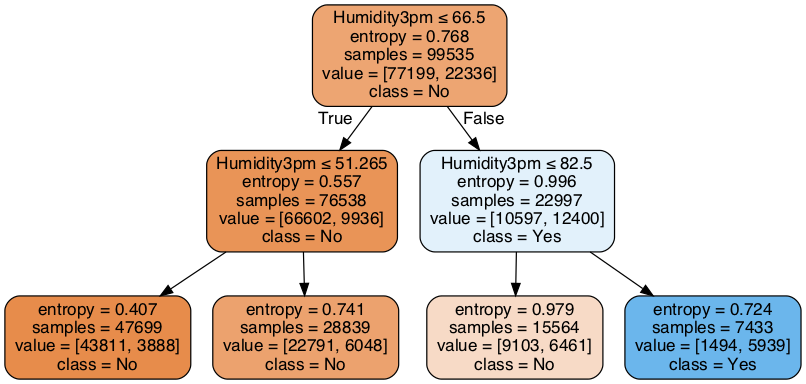
dt_model = Pipeline([('ct', ColumnTransformer(features)),
('clf', DecisionTreeClassifier(criterion='entropy', max_depth=6))])
dt_model.fit(x_train, y_train)
print('Classifition report on testing dataset\n')
print(classification_report(y_test, dt_model.predict(x_test)))
Classifition report on testing dataset
precision recall f1-score support
0 0.86 0.94 0.90 33117
1 0.69 0.48 0.57 9541
accuracy 0.84 42658
macro avg 0.78 0.71 0.73 42658
weighted avg 0.82 0.84 0.83 42658
from sklearn.neighbors import KNeighborsClassifier
nn_model = Pipeline([('ct', ColumnTransformer(features)),
('sca', StandardScaler()),
('clf', KNeighborsClassifier(n_neighbors=4))])
nn_model.fit(x_train, y_train)
print('Classifition report on testing dataset\n')
print(classification_report(y_test, nn_model.predict(x_test)))
Classifition report on testing dataset
precision recall f1-score support
0 0.80 0.97 0.88 33062
1 0.61 0.19 0.28 9596
accuracy 0.79 42658
macro avg 0.71 0.58 0.58 42658
weighted avg 0.76 0.79 0.74 42658
# plot decision tree rules
from sklearn.tree import export_graphviz
import pydotplus
dot_data = export_graphviz(dt_model.named_steps['clf'], out_file=None, feature_names=fs, class_names=['No', 'Yes'], filled=True, rounded=True, special_characters=True)
graph = pydotplus.graph_from_dot_data(dot_data)
from IPython.display import Image
Image(graph.create_png())

Sanity Check On Imputation¶
It is worth to check if we introduced some noice when doing imputation by testing the same algorithm on data where we drop all rows with any missing value.
features_no_imp = []
ff = ['Evaporation', 'Sunshine', 'Cloud9am', 'Cloud3pm', 'Humidity9am', 'Humidity3pm', 'RainToday',
'WindGustSpeed', 'Pressure9am', 'Pressure3pm', 'Temp3pm', 'Temp9am', 'MinTemp', 'MaxTemp',
'RainDaysWeek', 'DaysSinceRainWeek', 'Rainfall', 'WindSpeed9am', 'WindSpeed3pm', 'NoRainWeek']
features_no_imp += [(f, 'passthrough', [f]) for f in ff]
ff = ['Pressure3pm', 'Pressure9am']
features_no_imp += [('-PressureDiff', FunctionTransformer(np.diff), ff)]
features_no_imp += [('-PressureDrop', mp(FunctionTransformer(np.diff),
FunctionTransformer(gt0)), ff)]
ff = ['WindGustDir', 'WindDir9am', 'WindDir3pm', 'Location', 'Month', 'YearMonth']
features_no_imp += [(f, OneHotEncoder(drop='first', sparse=False, categories='auto'), [f]) for f in ff]
# train and evaluate decision tree
m = Pipeline([('ct', ColumnTransformer(features_no_imp)),
('clf', DecisionTreeClassifier(criterion='entropy', max_depth=6))])
df_no_na = df.dropna()
xtr, ytr, xte, yte = split(df_no_na, 'RainTomorrow', test_size=0.3)
m.fit(xtr, ytr)
print(classification_report(yte, m.predict(xte)))
precision recall f1-score support
0 0.87 0.95 0.91 12892
1 0.73 0.47 0.57 3574
accuracy 0.85 16466
macro avg 0.80 0.71 0.74 16466
weighted avg 0.84 0.85 0.83 16466
Evaluate¶
Confusion Matrix-based Evaluation Metrics¶
# confusion matrix
from sklearn.metrics import confusion_matrix, precision_score, recall_score
cm = confusion_matrix(dt_model.predict(x_test), y_test) # intentionally switched predictions with ground truth to have Predicted condition in rows
fig, ax = plt.subplots(figsize=(5, 5))
sns.heatmap(cm, cmap=sns.diverging_palette(220, 10, as_cmap=True), fmt='d', annot=True, annot_kws={'size': 15}, linewidths=.5)
ax.set_title('Confusion Matrix (predicted in rows)')
ax.set_ylim((0, 2))
ax.set_xlabel('True condition')
ax.set_ylabel('Predicted condition')
ax.invert_xaxis()
plt.yticks(rotation=0)
ax.xaxis.set_ticks_position('top')
ax.xaxis.set_label_position('top')
ax.tick_params(length=0);
print(f'Precision: {precision_score(y_test, dt_model.predict(x_test)):.2}, \
recall: {recall_score(y_test, dt_model.predict(x_test)):.2} on class 1')
Precision: 0.69, recall: 0.48 on class 1
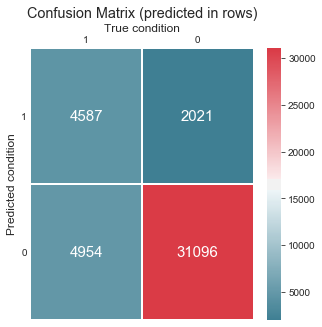
Wikipedia article about presion and recall has a perfect matrix describing various metrics that we can obrain from confusion matrix.
Precision, Recall, F1-score¶
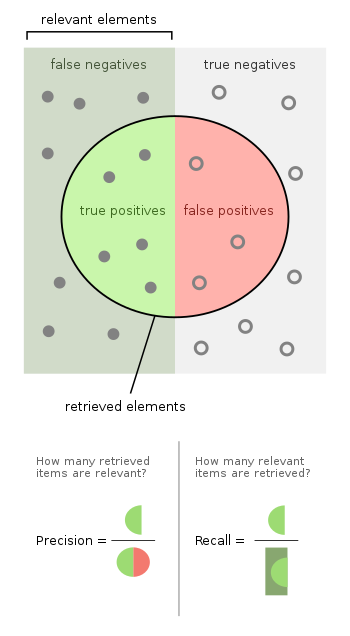

Precision, recall, and f1-score are other commonly used metrics.
Precision tells us how often when the models does positive prediction it is trully positive example.
Recall (also sensitivity and TPR) tells us how confident we can be that the model identified trully positive examples as positive.
There is always a tradeoff between precision and recall. Precision and recall are defined as follows:
F1-score is harmonic mean of precision and recall that offers one-number metric of model performance better than simple accuracy. Harmonic mean tends toward smaller values and is robust against high outliers thus F1-score highlights errors in predictions.
Precision, recall, and F1-score are best used with binary classification problem and they empasise performance on positive class and put less emphasis on negative class. That is intended in eg. medical applications where it more valuable to positively identify patients with illness rather than being certain about patiens not having and illness. Average class accuracy is good measure for cases when predictions for both classes are of the same importance.
Average Class Accuracy¶
# avg. class accuracy
from sklearn.metrics import recall_score
def avg_class_accuracy(y_true, y_pred):
recalls = recall_score(y_true, y_pred, average=None)
return np.sum(recalls) / recalls.shape[0]
print(f'Average class accuracy: {avg_class_accuracy(y_test, dt_model.predict(x_test)):.02}')
Average class accuracy: 0.71
Rates¶
Confusion matrix describes performance of classification model in full and is used as a base for various metrics highlighting different qualities of the model. The most basic being true positive rate (TPR), true negative rate (TNR), false positive rate (FPR), false negative rate (FNR). They are defined as follows.
Prediction Scores, Thresholds, and Curves¶
# distribution of predictions
y_score = ada_model.predict_proba(x_test)[:, 1]
fig, ax = plt.subplots(1, 2, figsize=(14, 5))
sns.distplot(y_score, ax=ax[0], label='Predictions')
ax[0].axvline(.5, 0, 20, c='k', label='Threshold 0.5')
sns.distplot(y_score, ax=ax[1], label='Predictions')
ax[1].axvline(.55, 0, 20, c='k', label='threshold 0.55')
for i in range(len(ax)):
ax[i].grid()
ax[i].set_title('Distribution of Predictions')
ax[i].set_xlabel('Prediction')
ax[i].set_ylabel('Density');
ax[i].legend()
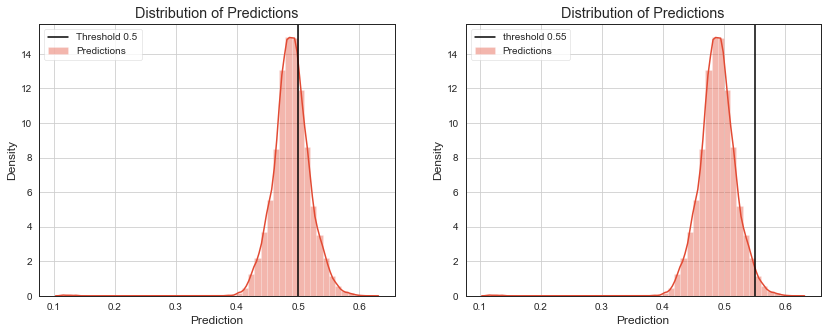
Many models do not output predicted class directly. They return prediction score that is thresholded to get predicted class as a output. Eg. logistic regression returns probability for positive class that is thresholded by \(0.5\), decision tree returns probability of majority class, naive bayes returns maximum posterior probability.
Checking how much distribution of scores for different classes overlap, gives some additional insight into model performance. We can also evaluate metrics like precision and recall for different thresholds to visualize their tradeoff.
ROC curve shows TPR (aka. sensitivity or recall) against FPR (1 - specificity). As threshold increases, TPR decreases (because we classify less and less as 1) and TNR increases (because we classify more and more as 0). FPR is (1 - TNR).
Precision vs Recall curve helps us to find sweet spot (threshold) to optimize model predictions for class 1. We can see that moving decision threshold to around \(0.495\) improves F1-score (on class 1) to \(0.63\) while it was \(0.59\) when using default threshold of \(0.5\).
# roc, precision, recall, fscore based on thresholds
from sklearn.metrics import roc_curve, roc_auc_score, precision_recall_curve
def plot_roc_curve(y_test, y_score, title):
fpr, tpr, thresholds = roc_curve(y_test, y_score)
auc = roc_auc_score(y_test, y_score)
plt.grid()
plt.plot(fpr, tpr, linewidth=3, label='ROC')
plt.fill_between(fpr, 0, tpr, alpha=0.5, label='AUC')
plt.xlim([0,1])
plt.ylim([0,1.05])
plt.xlabel('False positive rate')
plt.ylabel('True positive rate')
plt.title(title);
plt.legend()
return fpr, tpr, auc, thresholds
def plot_precision_recall_curve(y_test, y_score, title):
precision, recall, thresholds = precision_recall_curve(y_test, y_score)
thresholds_adjusted = np.append(thresholds, thresholds[-1])
f_score = 2 * precision * recall / (precision + recall)
plt.plot(thresholds_adjusted, precision, label='Precision', linewidth=3)
plt.plot(thresholds_adjusted, recall, label='Recall', linewidth=3)
plt.plot(thresholds_adjusted, f_score, label='F1-score', linewidth=3)
plt.grid()
ths_span = (thresholds[-1] - thresholds[0])*.1
plt.xlim((thresholds[0] - ths_span, thresholds[-1] + ths_span))
plt.title(title)
plt.legend(loc='lower left')
plt.xlabel('Threshold')
plt.ylabel('Score');
return precision, recall, f_score, thresholds
y_score = ada_model.predict_proba(x_test)[:, 1]
plt.figure(figsize=(14, 6))
plt.subplot(121)
fpr, tpr, auc, thresholds = plot_roc_curve(y_test, y_score, 'ROC')
plt.subplot(122)
precision, recall, f_score, thresholds = plot_precision_recall_curve(y_test, y_score, 'Precision vs. Recall')
print(f'Max F1 on testing data (class 1) {f_score.max():.2} with threshold {thresholds[np.argmax(f_score)]:.3}')
print(f'AUC on testing data (class 1) {auc:.2}')
Max F1 on testing data (class 1) 0.64 with threshold 0.506
AUC on testing data (class 1) 0.87
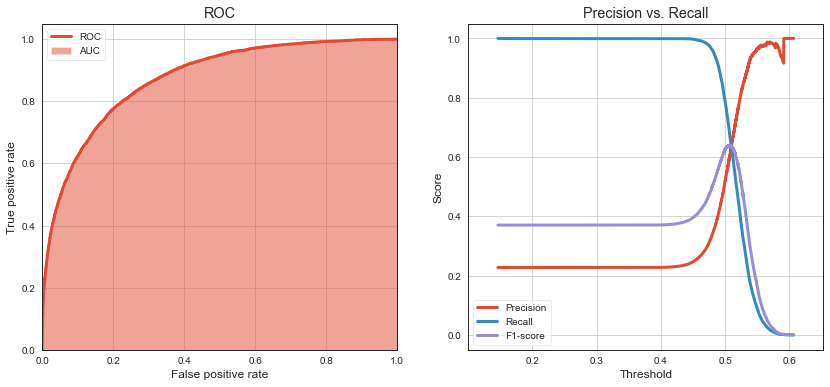
Bias, Variance Tradeoff¶

Joseph Rocca, Ensemble methods: bagging, boosting and stacking
Single decision tree performance is good enough to get some insights into features driving predictions but is rearly optimal. Decision tree tend to grow very deep and do not generalize well on unseen data. They have low bias but high variance.
Ensembles - Ways to Handle Bias, Variance Threshold¶
Ensemble Learning - Bagging, Boosting, Stacking

We can achieve better performace by using ensemble methods that help us trade variance for bias and vice versa. These methods usually train multiple weak (shallow) decision trees making a forrest out of them. Prediction of multiple models in ensemble is then usually a average of predictions from trees or a maximum.
Bagging¶
In bagging, we train multiple weak decision trees on subsets of data bootstrapped from the dataset. We average their predictions. Avaraging of predictions from weak models with high variance and low bias reduces variance. Bagging can be parallelised. Random forrests train forrest of strong decision trees on bootstraps and also randomly choose subset of features to make trees look different.

Boosting¶
In boosting, we train multiple weak decision trees again on subsets of data bootstrappedd from the dataset. In every step we weight data by the error previous models have on prediction to direct the next model to decide better about them. We combine weak models with high bias and low variance to reduce their bias using linear combination of their predictions. Coeficients of this linear combination describe how well weak model decided about the weighted dataset.

Stacking¶
In stacking, we train multiple heterogenous (weak) models and then we train another model that uses predictions of multiple models as an input to get final prediction. For example, we train logistic regression, SVM, kNN classifiers and then we train neural net to get final prediction.

We use adaptive boosting algorithm AdaBoost as and example of ensemble.
from sklearn.ensemble import AdaBoostClassifier, RandomForestClassifier
ada_model = Pipeline([('ct', ColumnTransformer(features)),
('clf', AdaBoostClassifier(
base_estimator=DecisionTreeClassifier(max_depth=3,
class_weight='balanced'),
n_estimators=20))])
ada_model.fit(x_train, y_train);
print('Ada Boosting Classifier')
print(classification_report(y_test, ada_model.predict(x_test)))
Ada Boosting Classifier
precision recall f1-score support
0 0.93 0.79 0.86 33276
1 0.52 0.77 0.62 9382
accuracy 0.79 42658
macro avg 0.72 0.78 0.74 42658
weighted avg 0.84 0.79 0.80 42658
We check another single model in this case gradient boosted tree in xgboost package. This is state of the art model suitable for many classification and regression problems.
from xgboost import XGBClassifier
xgb_model = Pipeline([('ct', ColumnTransformer(features)),
('clf', XGBClassifier(objective="binary:logistic"))])
xgb_model.fit(x_train, y_train);
print('Gradient Boosted Classifier')
print(classification_report(y_test, xgb_model.predict(x_test)))
Gradient Boosted Classifier
precision recall f1-score support
0 0.87 0.95 0.91 33011
1 0.75 0.50 0.60 9647
accuracy 0.85 42658
macro avg 0.81 0.73 0.75 42658
weighted avg 0.84 0.85 0.84 42658
Gain & Lift¶
# lift and gain curves
from sklearn.dummy import DummyClassifier
def cumgain(y_score, y_test):
n = y_test.shape[0]
ticks = np.linspace(0., 1., num=n, endpoint=True)
npos = y_test[y_test == 1].shape[0]
s = y_test.values[np.argsort(y_score)[::-1]]
cum_s = np.cumsum(s)
cum_gain = cum_s / npos # cumulative gain
return ticks, cum_gain
def cumlift(y_score, y_test):
ticks, mgain = cumgain(y_score, y_test)
n = y_test.shape[0]
npos = y_test[y_test == 1].shape[0]
ns = np.arange(1, n+1, step=1)
lift = (mgain * npos / ns) / (npos / n) # cumulative lift
return ticks, lift
def plot_gain_curve(model, x_test, y_test, title):
dclf = DummyClassifier(strategy='stratified', random_state=0)
dclf = sk.pipeline.Pipeline(model.steps[:-1] + [('clf', dclf)])
dmodel = dclf.fit(x_train, y_train)
ticks, m_gain = cumgain(model.predict_proba(x_test)[:,1], y_test)
ticks, d_gain = cumgain(dmodel.predict_proba(x_test)[:,1], y_test)
ticks, i_gain = cumgain(y_test, y_test)
plt.title(title)
plt.xlabel('Samples')
plt.ylabel('Cumulative Gain')
plt.xlim(0,1)
plt.ylim(0,1.02)
plt.grid(True)
plt.plot(ticks, d_gain, '-', color='blue', linewidth=3, label='Dummy')
plt.plot(ticks, i_gain, '--', color='blue', linewidth=3, label='Ideal')
plt.plot(ticks, m_gain, '-', color='red', linewidth=3, label='Model')
plt.legend(loc='lower right');
return ticks, m_gain
def plot_lift_curve(model, x_test, y_test, title):
dclf = DummyClassifier(strategy='stratified', random_state=0)
dclf = sk.pipeline.Pipeline(model.steps[:-1] + [('clf', dclf)])
dmodel = dclf.fit(x_train, y_train)
ticks, m_lift = cumlift(model.predict_proba(x_test)[:,1], y_test)
ticks, d_lift = cumlift(dmodel.predict_proba(x_test)[:,1], y_test)
ticks, i_lift = cumlift(y_test, y_test)
plt.title(title)
plt.xlabel('Samples')
plt.ylabel('Cumulative Lift')
plt.xlim(0,1)
plt.ylim(0.95, np.max(i_lift)*1.1)
plt.grid(True)
plt.plot(ticks, d_lift, '-', color='blue', linewidth=3, label='Dummy')
plt.plot(ticks, i_lift, '--', color='blue', linewidth=3, label='Ideal')
plt.plot(ticks, m_lift, '-', color='red', linewidth=3, label='Model')
plt.legend(loc='top right');
plt.figure(figsize=(14, 6))
plt.subplot(121)
plot_gain_curve(ada_model, x_test, y_test, 'Gain')
plt.subplot(122)
plot_lift_curve(ada_model, x_test, y_test, 'Lift')
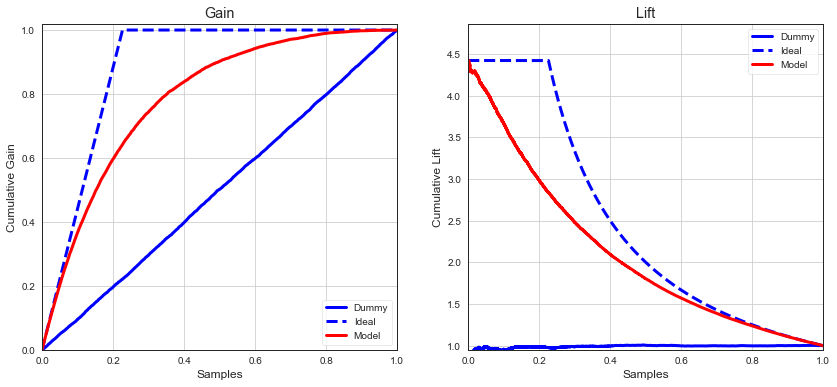
Gain¶
Gain measures how many of positive instanes in the overall test set are found in particular quartile.
Lift¶
Lift measures how much a model A is better than some benchmark model B.
Sometimes we want to act on predictions of class 1 only eg. to filter spam, report fraud, customers responding to campaign. Lift and gain metrics describes how well we would do if we ranked class 1 predictions by prediction score in descending order. In well performing model, we expect majority of true positive instances to be close to the top of ranking. Gain and lift measures to what extend this assumptions is correct.
Lift tells us how much higher the actual percentage of positive instances identified by model A is than the rate expected by model B.
Eg. in campaign optimization settings, cumulative gain tells us how many users we have to contact to target \(X%\) of users who are most likely to respons.
It’s sometimes handy to see gain and lift charts by decile for better comprehension.
# gain and lift by deciles
def declift(y_score, y_test):
deciles = np.linspace(10, 100, 10)
ticks, mgain = gain(y_score, y_test)
decgain = np.percentile(mgain, deciles)[::-1]
n = y_test.shape[0]
npos = y_test[y_test == 1].shape[0]
ns = np.percentile(np.arange(1, n+1, step=1), deciles)
lift = (decgain * npos / ns) / (npos / n) # decile lift
return lift
gains = np.diff(np.percentile(gain(y_score, y_test)[1], deciles), prepend=0)
lifts = declift(y_score, y_test)
plt.figure(figsize=(14, 7))
plt.subplot(121)
plt.title('Gain Deciles')
plt.xlabel('Decile')
plt.ylabel('Gain')
plt.grid(True)
plt.bar(deciles, gains, 10);
plt.subplot(122)
plt.title('Lift Deciles')
plt.xlabel('Decile')
plt.ylabel('Lift')
plt.grid(True)
# plt.ylim(0., lifts.max()*1.1)
plt.bar(deciles, lifts, 10);
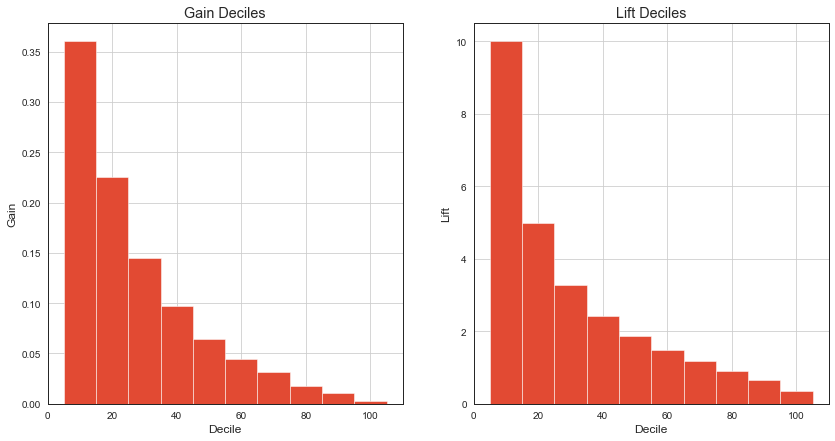
Learning Curve¶
Learning curves show progress in learning over time in terms of adding more samples to learn from. It can be used to:
Diagnose underfit, overfit, or well-fit model.
Tell if obtaining more data helps.
Tell if using more complex model or longer training times helps.
Underfitting refers to a model that cannot learn the training dataset.
Model not complex enough - we can see it by decreasing training curve or flat training curve on lower scores. Model can learn smaller datasets well, but as we are adding more data, model starts having difficulties to classify correctly.
More data needed - if training curve is increasing toward its end, it signals obraining more training data or giving model more time to learn would help.
Overfitting refers to a model that learned the training dataset too well including noise or randomness.
Training curve increases with experience and validation curve increases and than starts decreasing again. The inflection point is when we could stop training.
Good fit is identified by a training and validation curves that increase, become flat, and the generalization gap between training and validation curves is narrow.
Unrepresentative dataset means that the training dataset does not provide sufficient information to learn the problem. This is signaled by training curve converging to lower scores.
Some more details can be found here.
# learning curves
from sklearn.model_selection import learning_curve
def plot_learning_curve(model, x_train, y_train, title):
train_sizes, train_scores, test_scores = learning_curve(model, x_train, y_train)
train_scores_mean = np.mean(train_scores, axis=1)
train_scores_std = np.std(train_scores, axis=1)
test_scores_mean = np.mean(test_scores, axis=1)
test_scores_std = np.std(test_scores, axis=1)
plt.grid()
plt.title(title)
plt.xlabel('Training Samples')
plt.ylabel('Score')
plt.fill_between(train_sizes, train_scores_mean - train_scores_std,
train_scores_mean + train_scores_std, alpha=0.1,
color="r")
plt.fill_between(train_sizes, test_scores_mean - test_scores_std,
test_scores_mean + test_scores_std, alpha=0.1, color="g")
plt.plot(train_sizes, train_scores_mean, 'o-', color="r",
label="Training score")
plt.plot(train_sizes, test_scores_mean, 'o-', color="g",
label="Cross-validation score")
plt.legend(loc="best");
plt.figure(figsize=(20, 7))
plt.subplot(131)
plot_learning_curve(ada_model, x_train, y_train, 'AdaBoost')
plt.subplot(132)
plot_learning_curve(rf_model, x_train, y_train, 'Random Forrest')
plt.subplot(133)
plot_learning_curve(logit_model, x_train, y_train, 'Logistic Regression')
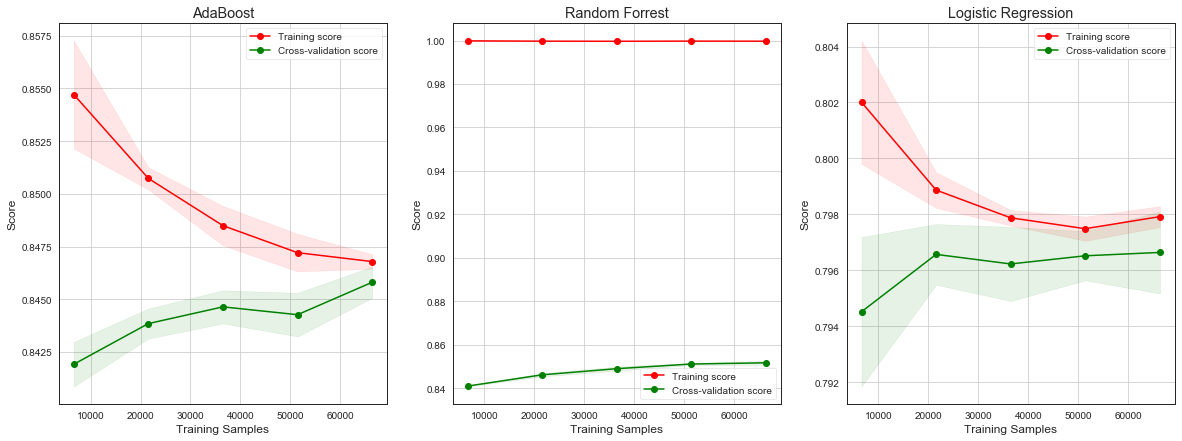
Hyper-parameter Tuning¶
Hyper-parameters are not-learned parameters of machine learning models like depth of a decision tree, voting rule, number of estimators in ensemble, …
Following are common techniques used for hyper-parameter search.
Grid search - exhaustive, goes through all possible combinations of given hyper-parameters and their values.
Randomized search - samples given number of possible combinations of given hyper-parameters and their distributions of values.
Bayesian optimization - Link
Some more details are available here and here.
We try to find the best set of parameters for our RainTomorrow weather problem.
from sklearn.linear_model import LogisticRegression
from sklearn.ensemble import VotingClassifier
from sklearn.model_selection import GridSearchCV, RandomizedSearchCV
from xgboost import XGBClassifier
train, test = train_test_split(df, test_size=.25)
Stacking More Models and Grid Search¶
pipeline = [('ct', ColumnTransformer(features)),
('sca', StandardScaler()),
('clf', VotingClassifier([('lr', LogisticRegression(solver='lbfgs')),
('rd', RandomForestClassifier(class_weight='balanced')),
('ada', AdaBoostClassifier(base_estimator=DecisionTreeClassifier(max_depth=3,
class_weight='balanced'))),
('xgb', XGBClassifier())], voting='soft'))]
params = {'clf__lr__max_iter': [2000, 3000],
'clf__lr__class_weight': ['balanced', {0:1, 1:10}],
'clf__rd__n_estimators': [5, 30, 50],
'clf__rd__max_depth': [5, 10],
'clf__xgb__n_estimators': [20, 30, 100],
'clf__xgb__max_depth': [2, 4],
'clf__voting': ['soft', 'hard']}
Cross-validation¶
Hyper-parameters tune machine learning algorithm, are given upfront and are not learned by it. Examples could be maximum number of iterations in logistic regression, number of estimators in random forrest, max depth of a weak learner in XgBoost.
It is recommended to search hyper-parameter space for the set of hyper-parameters with the best cross validation score.
Hyper-parameter search needs to evaluate many different versions of ML algorithm on the same dataset, we need to ensure some fairness in learning and evaluation.
Cross validation helps us to prevent overfitting of a model at hand by presenting it with data it hasn’t seen in training phase. It is similar to hold-out test set concept but generalize it when we need multiple such splits to evaluate perfomance of multiple models. It also prevents getting lucky split which put more difficult instances to the training data and easy instances to testing data. In \(k\)-fold cross validation, we split data into \(k\) folds (partitions), and we do \(k\) separate training and evaluation steps using \(k-1\) folds for training and the \(k\)th fold for evaluation in every step.
\(4\)-fold cross validation
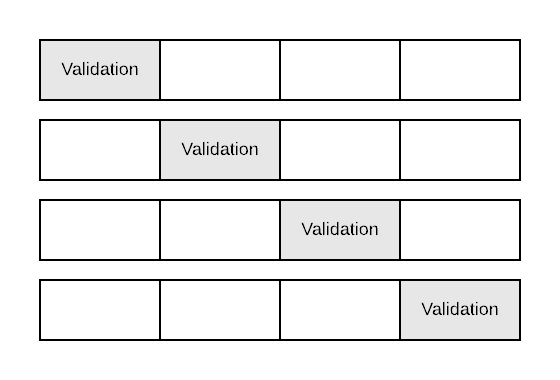
x_train = train.drop('RainTomorrow', axis=1)
y_train = train['RainTomorrow']
x_test = test.drop('RainTomorrow', axis=1)
y_test = test['RainTomorrow']
grid_model = GridSearchCV(Pipeline(pipeline),
param_grid=params,
n_jobs=-1, cv=3,
scoring='f1', iid=False, verbose=2)
grid_model.fit(x_train, y_train);
print(f'\nThe best cross-validation f1-score: {grid_model.best_score_}')
print(f'\nThe best parameters: {grid_model.best_params_}')
Fitting 3 folds for each of 288 candidates, totalling 864 fits
[Parallel(n_jobs=-1)]: Using backend LokyBackend with 4 concurrent workers.
[Parallel(n_jobs=-1)]: Done 33 tasks | elapsed: 24.1min
[Parallel(n_jobs=-1)]: Done 154 tasks | elapsed: 125.5min
[Parallel(n_jobs=-1)]: Done 357 tasks | elapsed: 257.5min
[Parallel(n_jobs=-1)]: Done 640 tasks | elapsed: 465.4min
[Parallel(n_jobs=-1)]: Done 864 out of 864 | elapsed: 621.7min finished
The best cross-validation f1-score: 0.6504555344192579
The best parameters: {'clf__lr__class_weight': 'balanced', 'clf__lr__max_iter': 3000, 'clf__rd__max_depth': 10, 'clf__rd__n_estimators': 50, 'clf__voting': 'soft', 'clf__xgb__max_depth': 4, 'clf__xgb__n_estimators': 100}
print('\nClassifition report on testing dataset\n')
print(classification_report(y_test, grid_model.predict(x_test)))
Classifition report on testing dataset
precision recall f1-score support
0 0.91 0.88 0.89 27479
1 0.62 0.69 0.65 8070
accuracy 0.83 35549
macro avg 0.76 0.78 0.77 35549
weighted avg 0.84 0.83 0.84 35549
Insights & Explanations¶
A bank needs to be able to explain why the loan wasn’t granted if the decision process was automatic. This is direct consequence of implementing GDPR in EU.
In October 2018 world headlines reported about Amazon AI recruiting tool that favored men. Amazon’s model was trained on biased data that were skewed towards male candidates. It has built rules that penalized résumés that included the word “women’s”.
Olga Mierzwa-Sulima, “Please, explain.” Interpretability of black-box machine learning models.
Having insight into internal configuration of learned model helps answering questions about trust and getting actionable information for stakeholders. Irrelevant or partially relevant features can negatively impact model perfomance. We can try to:
Feature Selection & Importance¶
Feature importance describes aggregated per-feature information.
Univariate statistical tests selects features with the highest variance in the data.
We can use linear model with L1 regularization like logistic regression or SVM for classification or Lasso for regression problems for selecting the best features for more complex model.
We can use learned model to output the most important features to tell us about its internal working.
Univariate Selection¶
Using Anova f-score of feature values and target label for univariate feature selection.
from sklearn.feature_selection import SelectKBest
from sklearn.feature_selection import f_classif
m = Pipeline([('ct', ColumnTransformer(features)),
('feature_selection', SelectKBest(score_func=f_classif, k=10)),
('clf', AdaBoostClassifier())])
m.fit(x_train, y_train)
fscores = pd.DataFrame({'feature': fs, 'score': m.named_steps['feature_selection'].scores_})
print(fscores.nlargest(10, 'score'))
feature score
3 Humidity3pm 23656.062117
23 Sunshine 11712.944411
28 RainToday 10283.188282
1 Cloud3pm 9502.777522
2 Humidity9am 7007.758958
0 Cloud9am 6539.568606
21 Rainfall 6005.641114
4 Pressure9am 5811.952766
20 WindGustSpeed 5318.624426
5 Pressure3pm 4856.702614
Select Features from Simple Model¶
Using simple logistic regression model with L1 regularization to filter features before feeding them to the more complex boosting model.
from sklearn.feature_selection import SelectFromModel
m = Pipeline([('ct', ColumnTransformer(features)),
('feature_selection', SelectFromModel
(LogisticRegression(penalty='l1', class_weight='balanced'),
threshold='median')),
('clf', AdaBoostClassifier())])
m.fit(x_train, y_train)
print(classification_report(y_test, m.predict(x_test)))
Classifition report on testing dataset
precision recall f1-score support
0 0.81 0.95 0.88 33131
1 0.59 0.22 0.32 9527
accuracy 0.79 42658
macro avg 0.70 0.59 0.60 42658
weighted avg 0.76 0.79 0.75 42658
m.steps.pop(len(m.steps) - 1)
t = m.transform(x_test)
print(f'Using {t.shape[1]} features for the final model')
Using 117 features for the final model
Feature Importance¶
We can visualize feature importance from a trained classifier.
# Feature importance
ada_model = AdaBoostClassifier()
ada_model.fit(x_train_trans, y_train)
# print(classification_report(y_test, ada_model.predict(x_test_trans)))
def plot_feature_importances(feature_names, importances, importances_for_std=None, threshold=None, figsize=(7, 7), title='Feature Importance'):
features = np.array(feature_names)
importances = pd.Series(importances).sort_values(ascending=True)
importances = importances[abs(importances) >= threshold] if threshold is not None else importances
indices = importances.index.values
std = np.std(importances_for_std[:, indices], axis=0) if importances_for_std is not None else None
plt.figure(figsize=figsize)
plt.title(title)
plt.barh(range(len(indices)), importances[indices], color="r", align="center", xerr=std)
plt.yticks(range(len(indices)), features[indices])
plt.ylim([-1, len(indices)])
plt.grid(True)
plot_feature_importances(fs, ada_model.feature_importances_, threshold=0.01)

Explain model as a whole using different kinds of feature importances.
Single predictions made by a model using eg. Lime or Shapley values.
Model as a Blackbox, Explain Single Prediction¶
Getting feature importance is not descriptive enough in many cases. We need to explain individual model predictions. Scenarios that follow are common use-cases of single prediction explanations.
Lime - Local Interpretable Model¶
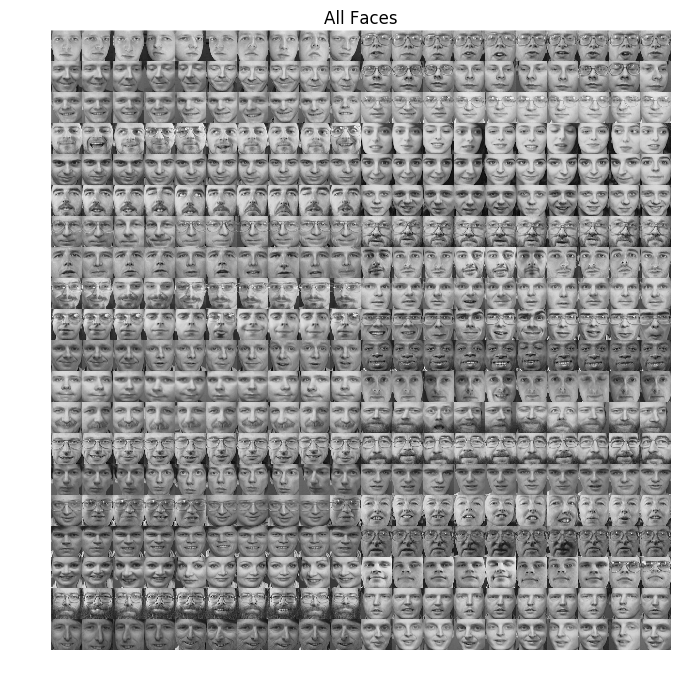
Lime, Olivetty dataset from AT&T Laboratories Cambridge
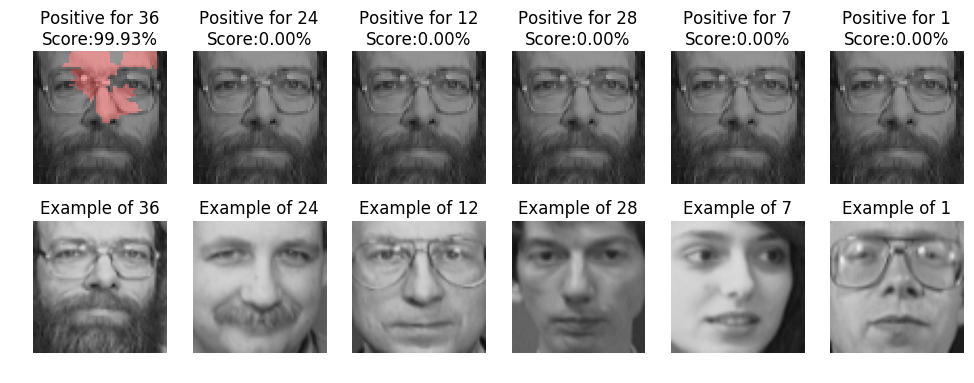
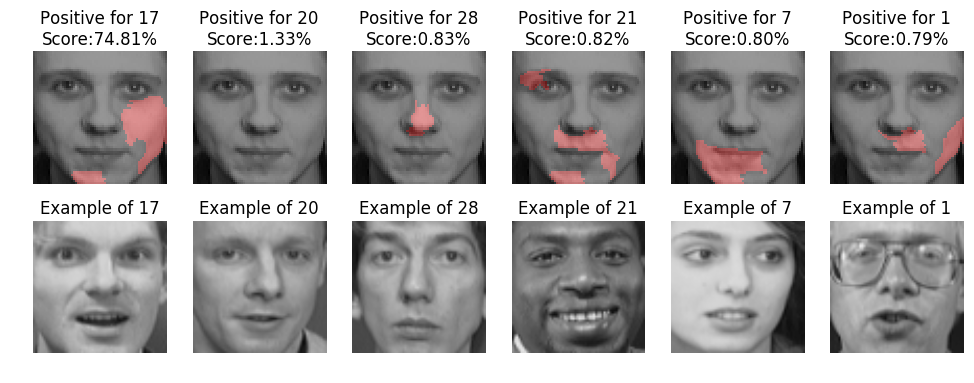
Lime tries to explain prediction for given data sample by fitting simple and directly interpretable model to sample of training data weighted by their distance to given data sample.
The black-box model’s complex decision function \(f\) (unknown to LIME) is represented by the blue/pink background, which cannot be approximated well by a linear model. The bold red cross is the instance being explained. LIME samples instances, gets predictions using f, and weighs them by the proximity to the instance being explained (represented here by size). The dashed line is the learned explanation that is locally (but not globally) faithful (link).

from sklearn.preprocessing import MinMaxScaler
from lime.lime_tabular import LimeTabularExplainer
m = Pipeline([('ct', ColumnTransformer(features)),
('feature_selection', SelectKBest(score_func=f_classif, k=10)),
])
xtr = m.fit_transform(x_train, y_train)
xte = m.transform(x_test)
scores = m.named_steps['feature_selection'].scores_
feature_names = np.array(fs)[np.flip(np.argsort(scores))[:10]]
m = AdaBoostClassifier()
m.fit(xtr, y_train);
lime_explainer = LimeTabularExplainer(xtr, feature_names=feature_names, class_names=['No', 'Yes'])
# examplaining single prediction
s = np.random.randint(0, xte.shape[0])
sample = xte[s]
exp = lime_explainer.explain_instance(sample, m.predict_proba, num_features=5, top_labels=1)
exp.show_in_notebook(show_table=True, show_all=False)
print(f'True label: {y_test.iloc[s]}')
True label: 0
Single explanations have a big disadvantage that we can hardly draw any conclusions about what drives groups of model predictions. Some combination of using feature importance and single explanations would be handy as many state of the art models are virtually black boxes.
Some basic approaches could be:
Try to turn features on and off and measure their impact on performance metrics.
Try to change feature values of some data points to see what drives model to alter prediction.
Shapley Values (SHapley Additive exPlanations)¶
Shapley values try to distribute contribution of features to modeled outcome fairly. It averages individual feature \(i\) contributions by adding it to all possible subsets of features. The contribution of adding feature \(i\) to some subset is also weighted by how many feature subsets is represents.
Feature \(i\) Shapley value \(\phi_i\) for model \(f\) and instance \(x\) is
where \(z'\) (\(x'\)) is simplified version of instance \(z\) (\(x\)) where some features are “zeroed”, \(M\) is the size of the full feature set. The bit at the end is just “how much bigger is the contribution when we add feature \(i\) to this particular subset \(z'\)”.
from xgboost import XGBClassifier
import shap
xgb_model = XGBClassifier(objective="binary:logistic", random_state=42)
xgb_model.fit(x_train_trans, y_train)
shap_explainer = shap.TreeExplainer(xgb_model)
shap_values = shap_explainer.shap_values(x_test_trans, y_test)
Individual prediction explanation. Red features push prediction higher, blue features push prediction lower.
shap.force_plot(shap_explainer.expected_value, shap_values[1,:], x_test_trans[1,:], feature_names=fs, matplotlib=True)

Feature importance plot giving us overview of Shapley value distributions and signs of the contribution.
Aggregated Shapley Values¶
shap.summary_plot(shap_values, x_test_trans, fs, class_names=['No', 'Yes'])
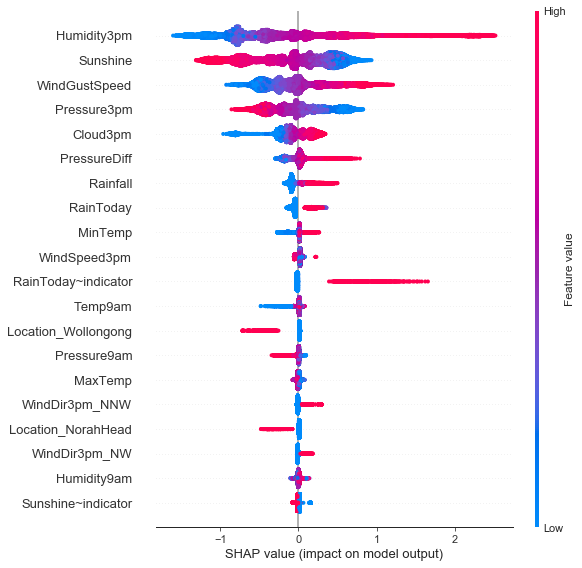
What Technology to Use¶
Technology stack in ML is much less matured compared to eg. software engineering. Best practices are undeveloped, it is very important to choose technology stack well.
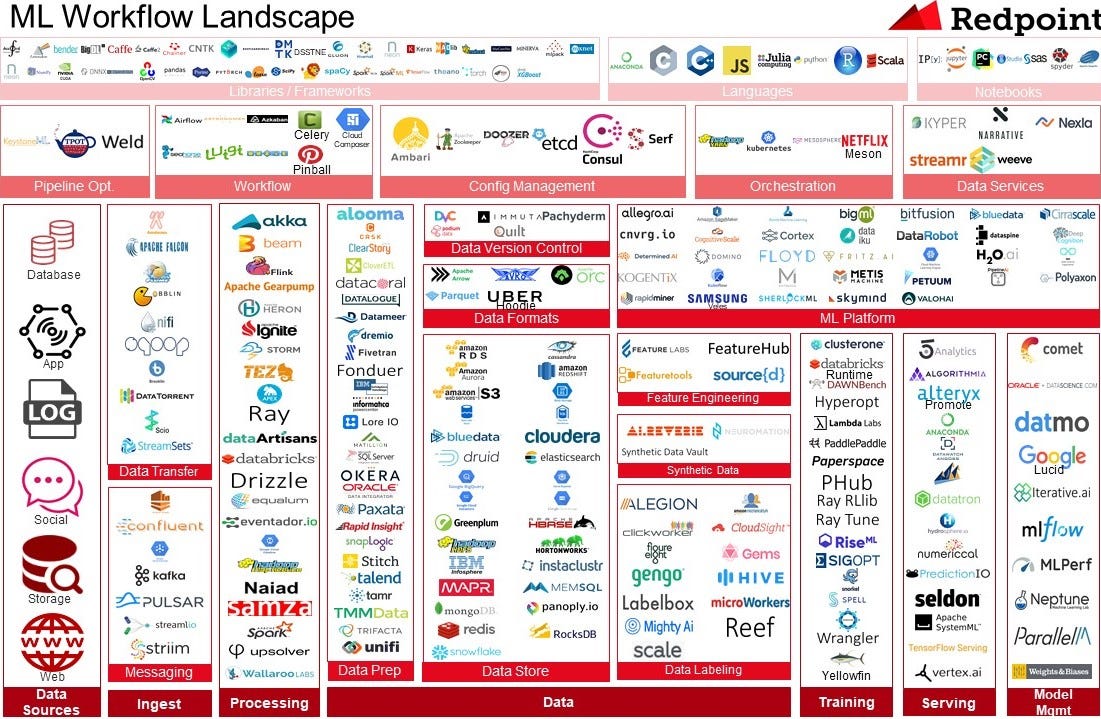
Astasia Myers, Introducing Redpoint’s ML Workflow Landscape
Impact of Data Size and Model Complexity¶
Take this with reserve, it’s just an example how to think about what basic technology will be needed.
Dataset Size |
Model Complexity |
Tool |
Hardware |
|---|---|---|---|
< 5GB |
Linear, Ensemble |
Scikit-learn |
CPU |
< 5GB |
DNN |
TensorFlow |
CPU |
< 100GB |
Linear |
eg. Vowpal Wabbit |
CPU |
< 100GB |
DNN |
TensorFlow |
CPU(s) |
< 100GB |
CNN, RNN |
TensorFlow |
GPU |
>= 100GB |
DNN, CNN, RNN |
TensorFlow |
GPU(s) |
DNN stands for deep fully connected network, CNN for convolutional neural network, and RNN for recurrent neural network. TensorFlow can be replaced with any other similar tool like PyTorch,
Sharing Knowledge in Team¶
Machine learning is iterative process, there are new ideas to try, new models to evaluate, new features to add, more data to play with. Sometimes datasets need to be revisited with fresh knowledge to crack modeling problem. Every analysis of data puts piece of puzzle in place. Knowledge has to be documented to be able to share it among data scientists in a form that is acceptible to them.
We made a good experience with following setup
We version our scratchpad and unfinished notebooks in git repository just to backup them at the one place.
When we finalize some data analysis or modeling, we create a knowledge post using Airbnb’s Knowledge Repository tool.
All knowledge posts share the same structure
tl;dr summary
Results
Data used, limitations
Analysis itself with comments
Appendix (mostly SQL code used)
All notebooks have to be self-contained with all SQL code needed to retrieve data. Anyone that needs to reiterate on the problem can run, replicate, and verify complete notebook.
Data analysis and modeling is usually not so satisfactory work on day or week span, it gets satisfacory over time though. Creating nicely formatted notebooks now and then largely improves satisfaction from daily work.
Example of knowledge repository.

Deploy & Monitor¶
After we deploy model into production, we have to monitor its perfomance. Models are built with some assumptions over distributions of input features and patterns learned from input features. Data changes over time causing concept drift and making models to lose performance, going stale, and requiring retraining (at least).
To monitor performance of the model we have to be notified about something has changed - ie. bug, concept-shift.
The perfomance metric of the model changed.
The distribution of individual features on model input changed.
The distribution of the outputs of the model changed.
Compare perfomance of the model on some business metric using control group.
# distribution of predictions
import scipy.stats as st
N = 1000
y1 = st.beta(10, 15).rvs(N)
y2 = st.beta(15, 10).rvs(N)
x = np.linspace(0, 1, N)
fig, ax = plt.subplots(1, 2, figsize=(14, 5))
sns.distplot(y1, ax=ax[0], label='Predictions')
ax[0].axvline(.5, 0, 20, c='k', label='Threshold 0.5')
sns.distplot(y2, ax=ax[1], label='Predictions')
ax[1].axvline(.5, 0, 20, c='k', label='threshold 0.5')
ax[0].set_title('Distribution of Predictions Before')
ax[1].set_title('Distribution of Predictions After')
for i in range(len(ax)):
ax[i].grid()
ax[i].set_xlabel('Prediction')
ax[i].set_ylabel('Density');
ax[i].legend()
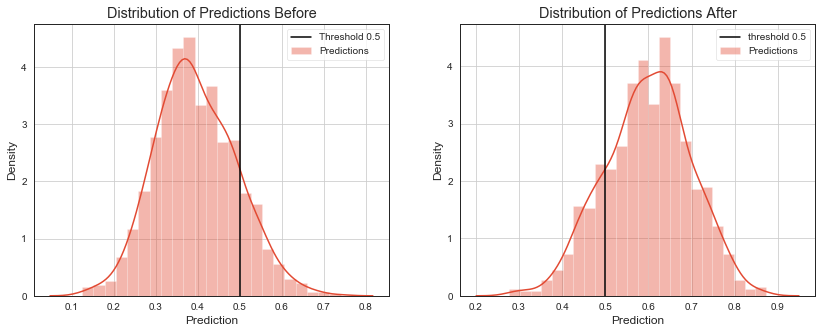
To monitor the change in the performance metrics of the model would require to acquire true label soon after prediction of the model is made which is usually hard.
If we act on several deciles of “best” predictions only, we can check ratio of how many samples are above some threshold versus how many sample is below the threshold. This ratio should be stable from test set to production. If it changes, it signals a change in distribution of model outputs.
Stability Index¶
We can use stability index to measure changes in distribution of model outputs.
Distributions are silimar if stability index is less than 0.1, has some change for stability index <= 0.25 and stability index > 0.25 suggests that there has been significant change.
Keep Training and Production Environments Same¶
We try to keep following rules in mind when deciding about deployment.
Training and production environment should be as similar as possible.
There should be as less transformations applied to data prior they enter our ML pipeline as possible. Working with meaningful and yet unscaled values simplifies model debuging a lot. Mind that there are no tools to debug misbehaving models.
Following depicts one way how to create modeling in python declarative in few lines of code shielding most of the boiler-place code, training, and evaluation routines that are always the same.
ModelRunner is still Avast proprietary implementation that we might open-source some time.
You find implementation of most ModelRunner steps above in this notebook.
ModelRunner Abstraction¶
pipeline = [('sca', sk.preprocessing.StandardScaler()),
('clf', LogisticRegression(C=1.0))]
# template class configured with data, higher-level features, model, evaluators
# it does train-test split, training, evaluation in declarative way
foo = ModelRunner(data_source,
[Features.LocationToLabel_ratio,
Features.WindGustSpeed_log,
Features.PressureDiff],
[ClassificationReportEvaluator(), ConfusionMatrixEvaluator()],
default_pipeline=pipeline,
include_columns=['NoRainWeek'])
foo.evaluate()
[
Classification report on testing data
precision recall f1-score support
0 0.58 0.43 0.50 123
1 0.67 0.79 0.72 177
avg / total 0.63 0.64 0.63 300,
Confusion matrix on testing data
[[ 53 70]
[ 38 139]]]
# standardize somehow evaluations used to tune model
metrics = evaluate_model(foo.get_estimator(), foo.get_data(), 'Foo Model Evaluation')
Classification report on testing data
precision recall f1-score support
0 0.49 0.41 0.44 123
1 0.63 0.71 0.67 177
avg / total 0.57 0.58 0.58 300
Confusion matrix on testing data
[[ 50 73]
[ 52 125]]
AUC on testing data 0.655390
Max F1 on testing data: 0.7468354430379746
Lift of the model at 10% of testing data is: 1.500000
Lift of the model at 20% of testing data is: 1.411765
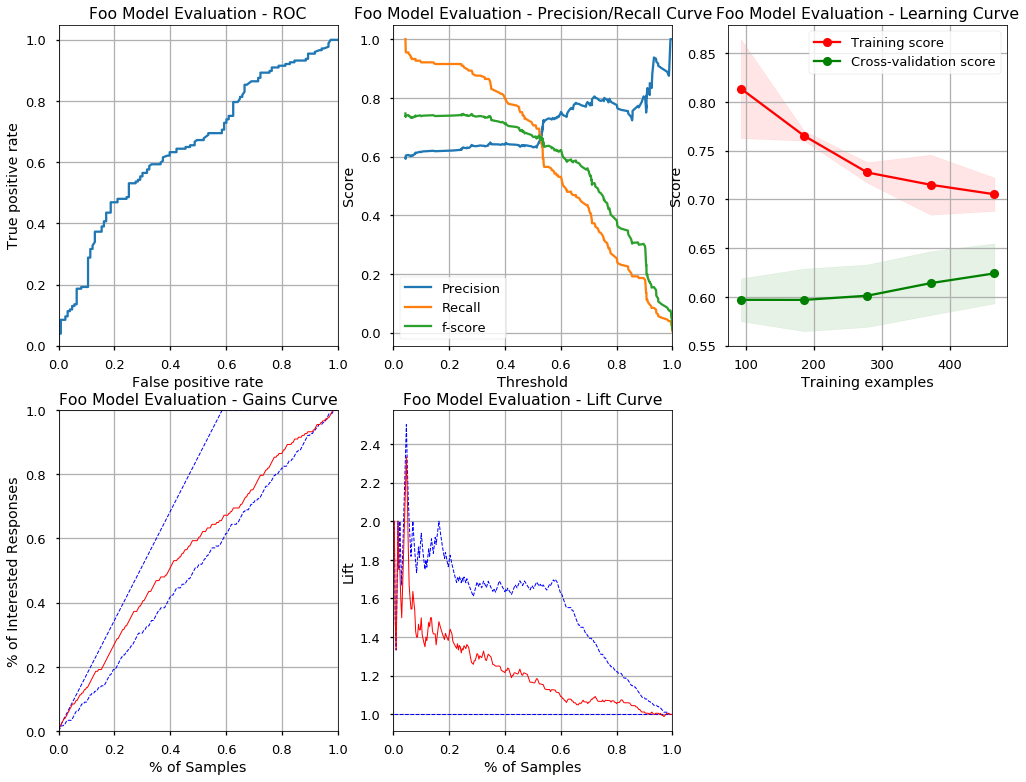

Machine learning steps like splitting data for cross validation, training, evaluation, prediction are always the same. Many business applications are using the same data and the same transformations of the data again and again. It is much more practical to have some catalog of higher level features we can use to declaratively configure our solution.
ModelRunner is template class that implements machine learning workflow for classification or regression.
ModelRunner is configured with DataSource to be able to load dataset.
DataSource calls instance of Extractor that specifies how to query for data eg. querying underlying database via Connection and eg. SQL.
ModelRunner also receives list of Features. Every Feature maps some columns from training (testing) data frame to list of Transformers. This allows us to declaratively reuse commonly used features rather than coding them again and again in Pipeline.
ModelRunner evaluates its estimator (specified as Pipeline) using list of Evaluators where every Evaluator stands for one metric eg. AUC for classification or MSE for regression.
ModelRunner can pickle and unpickle itself to allow us to move trained models from one place to another.
We can unit-test every component (Extractor instances, custom sklearn transformers, Evaluators and ModelRunner instances (trained models) in isolation and deploy their code using standard CI/CD techniques. Once the code is deployed in production, we only move pickled instance of ModelRunner and unpickle it.
Extractor abstraction allows us to use one trained instance of ModelRunner with different source of data.
We can prepare data via SQL query to Hive database in training phase using Extractor that uses database connection.
We can get predictions for batches of data using Extractor that reads incoming RabbitMQ messages in production.

Resources¶
John D. Kelleher et al., Fundamentals of Machine Learning for Predicitve Data Analytics
Sebastian Raschka, Python Machine Learning
Ian Goodfellow et al., Deep Learning

